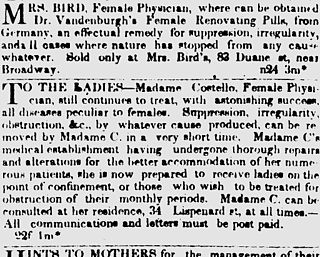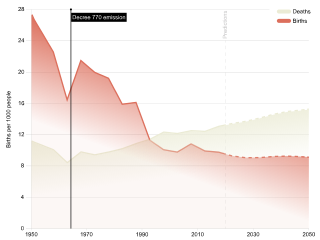
Birth rate, also known as natality, is the total number of live human births per 1,000 population for a given period divided by the length of the period in years. The number of live births is normally taken from a universal registration system for births; population counts from a census, and estimation through specialized demographic techniques. The birth rate is used to calculate population growth. The estimated average population may be taken as the mid-year population.

Abortion laws vary widely among countries and territories, and have changed over time. Such laws range from abortion being freely available on request, to regulation or restrictions of various kinds, to outright prohibition in all circumstances. Many countries and territories that allow abortion have gestational limits for the procedure depending on the reason; with the majority being up to 12 weeks for abortion on request, up to 24 weeks for rape, incest, or socioeconomic reasons, and more for fetal impairment or risk to the woman's health or life. As of 2022, countries that legally allow abortion on request or for socioeconomic reasons comprise about 60% of the world's population. In 2024, France became the first country to explicitly protect abortion rights in its constitution.
Reproductive rights are legal rights and freedoms relating to reproduction and reproductive health that vary amongst countries around the world. The World Health Organization defines reproductive rights as follows:
Reproductive rights rest on the recognition of the basic right of all couples and individuals to decide freely and responsibly the number, spacing and timing of their children and to have the information and means to do so, and the right to attain the highest standard of sexual and reproductive health. They also include the right of all to make decisions concerning reproduction free of discrimination, coercion and violence.
Abortion in Germany is decriminalized on demand during the first 12 weeks of pregnancy upon condition of mandatory counseling. The same goes later in pregnancy in cases that the pregnancy poses an important danger to the physical or mental health of the pregnant woman. In the case that the abortion is because of a rape counseling is not mandatory. The woman needs to receive counseling, called Schwangerschaftskonfliktberatung, at least three days prior to the abortion and must take place at a state-approved centre, which afterwards gives the applicant a Beratungsschein.

The practice of induced abortion—the deliberate termination of a pregnancy—has been known since ancient times. Various methods have been used to perform or attempt abortion, including the administration of abortifacient herbs, the use of sharpened implements, the application of abdominal pressure, and other techniques. The term abortion, or more precisely spontaneous abortion, is sometimes used to refer to a naturally occurring condition that ends a pregnancy, that is, to what is popularly called a miscarriage. But in what follows the term abortion will always refer to an induced abortion.
Abortion is illegal in El Salvador. The law formerly permitted an abortion to be performed under some limited circumstances, but in 1998 all exceptions were removed when a new abortion law went into effect.
Abortion in Switzerland is legal during the first twelve weeks of pregnancy, upon condition of counseling, for women who state that they are in distress. It is also legal with medical indications – threat of severe physical or psychological damage to the woman – at any later time. Switzerland is among the developed nations with the lowest rates of abortions and unwanted pregnancies.
Abortion in Russia is legal as an elective procedure up to the 12th week of pregnancy, and in special circumstances at later stages.
Abortion in Panama is illegal except in instances that the pregnancy is life-threatening or the health of the woman is at risk, or if the pregnancy is the result of rape or incest.
Abortion in Venezuela is currently illegal except in some specific cases outlined in the Venezuelan Constitution, and the country has one of Latin America's most restrictive laws.

Decree 770 was a decree of the communist Romanian government of Nicolae Ceaușescu, signed in 1967. It restricted abortion and contraception, and was intended to create a new and large Romanian population. The term decreței is used to refer to those Romanians born during the time period immediately following the decree.
Orphanhood in Romania became prevalent as a consequence of the Socialist Republic of Romania's pro-natality policy under Nicolae Ceaușescu. Its effectiveness led to an increase in birth rates at the expense of adequate family planning and reproductive rights. Its consequences were most felt with the collapse of the regime's social safety net during the Romanian austerity period, which led to widespread institutional neglect of the needs of orphans, with severe consequences in their health and well-being. A series of international and governmental interventions have taken place since the 1990s to improve the conditions in orphanages and reform the country's child protection system, with variable degrees of success.
The tax on childlessness was a natalist policy imposed in the Soviet Union and other Communist countries, starting in the 1940s. Joseph Stalin's regime created the tax in order to encourage adult people to reproduce, thus increasing the number of people and the population of the Soviet Union. The 6% income tax affected men from the age of 25 to 50, and married women from 20 to 45 years of age.
Abortion in Austria has not been punishable by law during the first three months of pregnancy since 1 January 1975. Abortions can be performed later if there is a physical or mental health threat to the pregnant person, if there is an incurable problem with the development of the fetus, or if the patient is under the age of 14. Generally, performing or receiving an abortion is still considered a criminal offence.
Forced abortion is a form of reproductive coercion that refers to the act of compelling a woman to undergo termination of a pregnancy against her will or without explicit consent. Forced abortion may also be defined as coerced abortion, and may occur due to a variety of outside forces such as societal pressure, or due to intervention by perpetrators such as an intimate partner, parental guardian, medical practitioners, or others who may cause abortion by force, threat or coercion. It may also occur by taking advantage of a situation where a pregnant individual is unable to give consent, or when valid consent is in question due to duress. This may also include the instances when the conduct was neither justified by medical or hospital treatment, which does not include instances in which the pregnant individual is at risk of life threatening injury due to unsustainable pregnancy. Similar to other forms of reproductive coercion such as forced sterilization, forced abortion may include a physical invasion of female reproductive organs, therefore creating the possibly of causing long term threat or injury preventing viable future pregnancies. Forced abortion is considered a human rights violation by the United Nations due to its failure to comply with the human right to reproductive choice and control without coercion, discrimination, and violence.
Abortion is a controversial topic in Nigeria. Abortion in Nigeria is governed by two laws that differ depending on geographical location. Northern Nigeria is governed by The Penal Code and Southern Nigeria is governed by The Criminal Code. The only legal way to have an abortion in Nigeria is if having the child is going to put the mother's life in danger. However, sex-selective abortion has long had acceptance in Nigeria.

Abortion in South Korea was decriminalized, effective 1 January 2021, by a 2019 order of the Constitutional Court of Korea.
Communist and Marxist ideologies generally allow state-provided abortion, although there is no consensus among Communist parties and governments about how far into the pregnancy abortion should be allowed.
In Yemen, abortions are only “permitted to save the life of a pregnant woman”, making it one of the strictest abortion laws in the Middle East and the world. Abortion is not widely accepted in Yemeni society. However, because of the recent conflict in Yemen, rape, honor killings, and unsafe abortions have increased in Yemen. According to a study conducted by Canadian Studies in Population, the number of unsafe and illegal abortions are high in Yemen, which can lead to fatal health risks for women.
Abortion in Singapore is legal and widely accessible. It was formally legalised in 1974, being one of the first countries in Asia to do so. It is available on request for Singaporean citizens, permanent residents, individuals with an issued student or work pass, individuals who have been a resident of Singapore for a minimum of four months as well as anyone married to a Singaporean citizen or a permanent resident. Foreigners may also obtain an abortion in Singapore if their lives are endangered.






